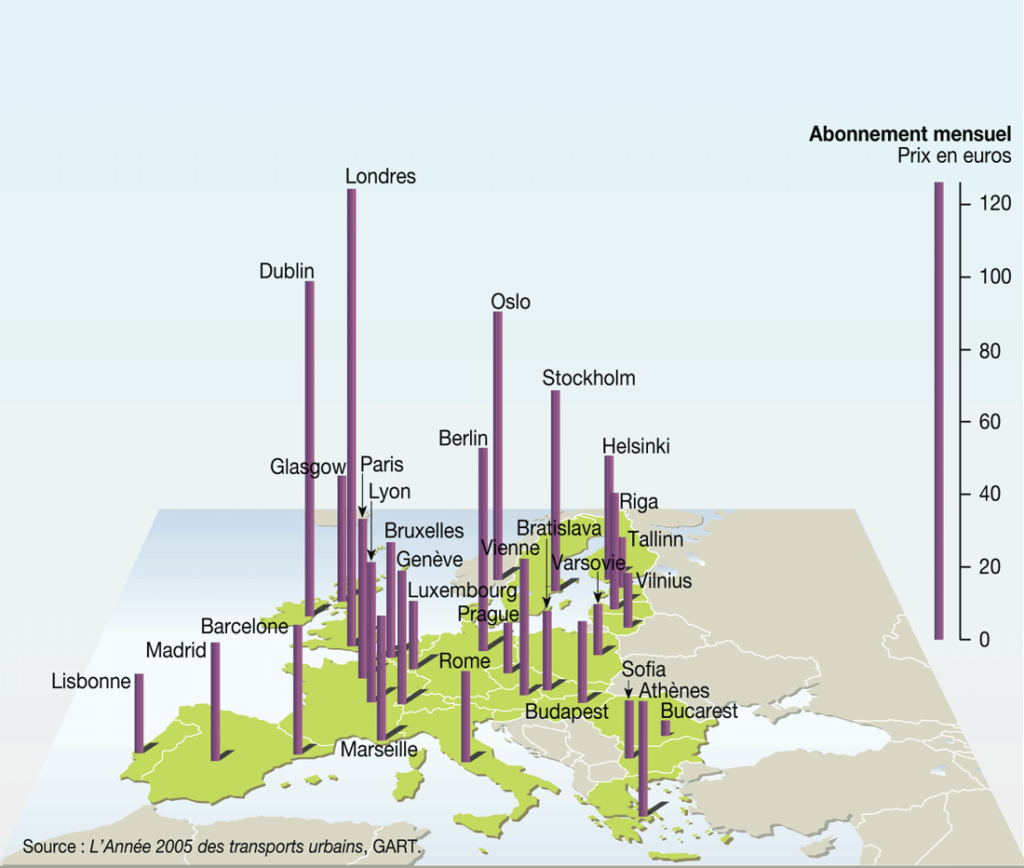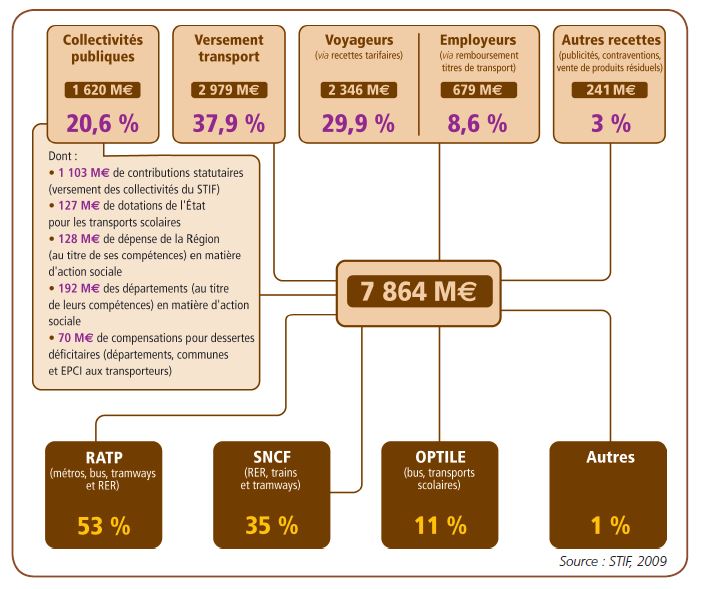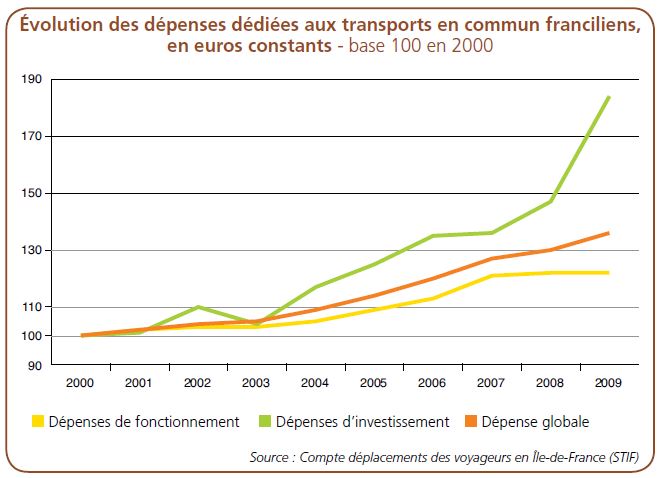The recent release of a report by the Court of Auditors about the annual fraud cost on public transport in Ile-de-France region (as a reminder: about 1 million euros per day [1]), led me to read many more or less virulent reactions on the subject. Between ” Fraud is not good, good payers pay for others,” People cheat because it’s too expensive », « Transport is a public service and should therefore be free or “the If the RATP provided a better service, I would pay for my tickets” no one really seemed to go along with the source of the trouble and the solutions. I realized that beyond the issue of fraud, few people knew the real cost of public transportation and the complex economic balance they conceal.
If you stop a random person on the streets of Paris, chances are that they know the “basic” price of transport in Paris (except perhaps Nathalie Kosciusko Morizet wink): ticket T at 1.80 euros for zones 1 to 2 andNavigo passes at a single rate of 70 euros for zones 1 to 5 since September 2015. We often hear people complaining about the high fare of public transport in Ile-de-France, but you should know that these 1.80 euros that make us sigh so much are only the tip of the iceberg. I’ll make a revelation: this actually represents only 1/3 of the actual cost (tadaaaam!).
A bus ticket actually costs a little more than 5 euros and the navigo pass monthly a little more than 200 euros …
Grass is not necessarly greener elsewhere
When we contrast transport prices in Paris to other European capitals, we quickly realize that Parisian prices (and more generally French prices) are relatively low compared to our European neighbours [2], especially in Northern Europe. This is spotlighted by the map below, which, although somewhat dated, shows some huge gaps:

I remember my surprise, during my Erasmus exchange in Sweden in front of the price of transport in Stockholm (440 Swedish kronor for 10 tickets zones A and B (almost 50 euros). Even worse in London, where despite the introduction of the “Oyster card”, the rates remain very high, with a monthly subscription from £93 to £385, depending on the areas chosen! Let’s not talk about the fraud penalties, which are quite deterrent (40 euros in Berlin and £80 in London), with more frequent checks than Paris.
On the other hand, I was pleasantly surprised during my trips to Lisbon and Barcelona to find transport at more than reasonable rates. France is therefore more in the low average in terms of transport prices.
Of course, we must balance these higher or lower prices with the standard of living – higher in Northern Europe than in Southern Europe – as well as the quality of the networks, which is excellent for example in Scandinavia (taking the commuter train “S-tog” in Copenhagen , a kind of hybrid between an RER and a Transilien, is a real joy). This high quality service has therefore a huge impact on the cost of the ticket.
On the other hand, public subsidies are often lower in the Nordic countries compared to France. This is especially the case in England, where transport privatisation was initiated in the mid-1980s (Hi Margaret Thatcher!). Users pay the high price, but that is actually the “real price” of transport. The question then arises: in Paris region, where does the additional funding that cover the remaining 2/3 of the ticket price come from?
Real cost of public transportation: A finance ensured mainly by companies and communities
The STIF website highlights the transport financing in France [3], spreaded as follows in 2014:

The first public transport funding stem from local firms, through the VT (Transport Payment). Any company with more than 10 employees pays employer charges to finance the public transport. These revenues are then assigned to the transport authorities (the STIF in this case for Paris area). This tax represents, depending on the companies location, 1.5% to 2.7% of the total payroll. As for the STIF, the transport payment represents 3.6 billion euros in 2014 (65% of its budgetary recipe and almost 40% of the total funding).
Half of the funding is provided by the Ile-de-France region, and the rest is distributed among the departments of France. These contributions from local authorities are financed mainly by local taxes and property taxes borne by households and businesses. Finally, the State also subsidizes part of the ticket price, but to a lower rate than local authorities.
An OMNIL report [4] covering the period 2000-2009 shows that the share of users revenues represents only 30% of the total STIF revenues in 2009:

This same study also shows that the share of household contributions (i.e. the purchase of tickets or subscriptions) was generally constant over the period 2000-2009:

Interestingly, the state is gradually withgetting transport funding in the Ile-de-France region, leaving more responsibility for local authorities, especially the region. This change was driven by the wave of decentralization of 2002-2003 and the constitutional law of March 28th 2003, ratified under the Raffarin government [5].
Real cost of public transportation: A sensitive economic balance
The problem is that local authorities have inherited these responsibilities without necessarily benefiting from equivalent funding, leading to a shaky budgetary balance. Ile-de-France specificly has to deal with old and ageing infrastructures in addition to a greater transport demand (for example more than 2 million daily passengers on the A line of the RER). Major maintenance is scheduled every summer until 2021, requiring a complete traffic disruption. Moreover, urban sprawl in Ile-de-France means the extension of existing lines or the construction of new lines (see the Greater Paris project), sometimes at enormous costs.
If we look at the overall expenditure on public transport in France over the period 2000-2009, operating expenditure has increased by 45%, while in comparison capital expenditure has increased by 119%!

And if we look at the evolution of operating expenses VS the capital expenditure in constant euros, the gap is even more impressive!

Another illustration of this uncertain budgetary balance: the creation of the Navigo single-price pass, a very symbolic measure introduced on September 2015, which is at first glance a good news for users (although this point is questionable [6]). But from an economic perspective, this measure led to revenue decrease estimated in 2016 at 485 million euros by the regional council [7]. Loss that will have to be partially compensated by employers up to 210 million euros via the increase of the Transport Payment. What about the rest? The track mentioned for the moment between Valérie Pécresse, president of Ile-de-France, and Manuel Valls, prime minister, would be to erase a debt of 300 million euros of the regions toward RATP [8], at least for 2016…
I hope that this article will have given you a slightly more global view of our transport, and that you will look at your bus ticket in the future with a different eye. Wink
[4] http://www.omnil.fr/IMG/pdf/transports_en_commun_en_chiffres_edition_2000-2009.pdf
[5] https://fr.wikipedia.org/wiki/DC3A9centralisation_en_France#D.C3.A9centralisation_territoriale




